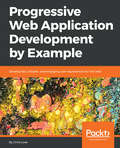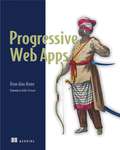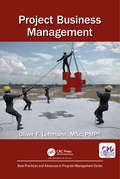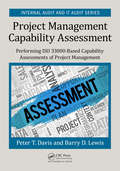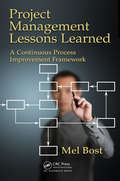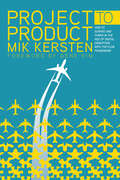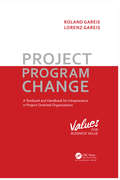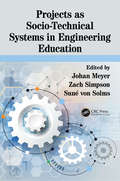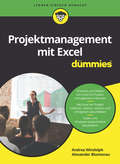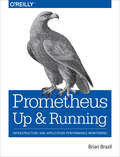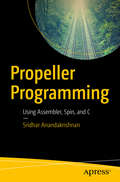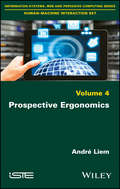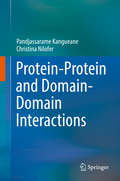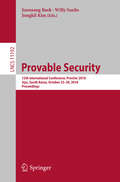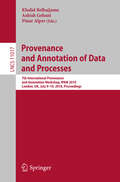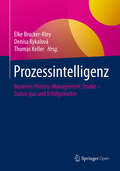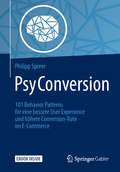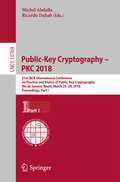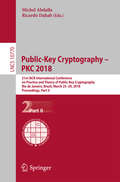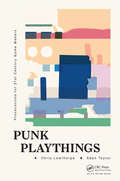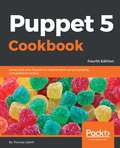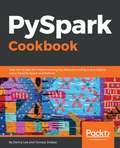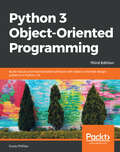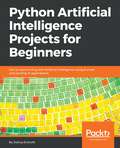- Table View
- List View
Progressive Web Application Development by Example: Develop fast, reliable, and engaging user experiences for the web
by Chris LoveLeverage the full potential of the web to make your web sites better than native applications for every platform. Key FeaturesExplore different models and patterns required to develop progressive web applicationsCreate applications requiring shorter runtime for attracting more usersStudy different projects to understand the fundamentals of progressive web applicationsBook DescriptionAre you a developer that wants to create truly cross-platform user experiences with a minimal footprint, free of store restrictions and features customers want? Then you need to get to grips with Progressive Web Applications (PWAs), a perfect amalgamation of web and mobile applications with a blazing-fast response time.Progressive Web Application Development by Example helps you explore concepts of the PWA development by enabling you to develop three projects, starting with a 2048 game. In this game, you will review parts of a web manifest file and understand how a browser uses properties to define the home screen experience. You will then move on to learning how to develop and use a podcast client and be introduced to service workers. The application will demonstrate how service workers are registered and updated. In addition to this, you will review a caching API so that you have a firm understanding of how to use the cache within a service worker, and you'll discover core caching strategies and how to code them within a service worker.Finally, you will study how to build a tickets application, wherein you’ll apply advanced service worker techniques, such as cache invalidation. Also, you'll learn about tools you can use to validate your applications and scaffold them for quality and consistency. By the end of the book, you will have walked through browser developer tools, node modules, and online tools for creating high-quality PWAs.What you will learnExplore the core principles of PWAs Study the three main technical requirements of PWAs Discover enhancing requirements to make PWAs transcend native apps and traditional websites Create and install PWAs on common websites with a given HTTPS as the core requirementGet acquainted with the service worker life cycle Define service worker caching patternsApply caching strategies to three different website scenariosImplement best practices for web performanceWho this book is forProgressive Web Application Development by Example is for you if you’re a web developer or front-end designer who wants to ensure improved user experiences. If you are an application developer with knowledge of HTML, CSS, and JavaScript, this book will help you enhance your skills in order to develop progressive web applications, the future of app development.
Progressive Web Apps
by Dean HumeSummaryProgressive Web Apps teaches you PWA design and the skills you need to build fast, reliable websites by taking you step-by-step through real world examples in this practical tutorial. Foreword by Addy Osmani, Google.Purchase of the print book includes a free eBook in PDF, Kindle, and ePub formats from Manning Publications.About the TechnologyOffline websites that work. Near-instant load times. Smooth transitions between high/low/no bandwidth. Fantasy, right? Not with progressive web applications. PWAs use modern browser features like push notifications, smart caching, and Service Workers to manage data, minimize server usage, and allow for unstable connections, giving you better control and happier customers. Better still, all you need to build PWAs are JavaScript, HTML, and the easy-to-master techniques you'll find in this book.About the BookProgressive Web Apps teaches you PWA design and the skills you need to build fast, reliable websites. There are lots of ways you can use PWA techniques, and this practical tutorial presents interesting, standalone examples so you can jump to the parts that interest you most. You'll discover how Web Service Workers vastly improve site loading, how to effectively use push notifications, and how to create sites with a no-compromise offline mode. What's InsideImproved caching with Service WorkersUsing manifest files and HTML markupPush notificationsOffline-first web designsTechniques for data synchronizationAbout the ReaderWritten for readers with experience developing websites using HTML, CSS, and JavaScript.About the AuthorDean Alan Hume is a coder, author, and Google Developer Expert. He's passionate about web performance and user experience.Table of ContentsPART 1 - DEFINING PROGRESSIVE WEB APPS Understanding Progressive Web Apps First steps to building a Progressive Web App PART 2 - FASTER WEB APPS Caching Intercepting network requests PART 3 - ENGAGING WEB APPS Look and feel Push notifications PART 4 - RESILIENT WEB APPLICATIONS Offline browsing Building more resilient applications Keeping your data synchronized PART 5 - THE FUTURE OF PROGRESSIVE WEB APPSStreaming data Progressive Web App troubleshooting The future is looking good
Project Business Management (Best Practices in Portfolio, Program, and Project Management)
by Oliver F. LehmannRoughly half of all project managers have to lead customer projects as profit centers on contractor side with two big objectives: making the customer happy and bringing money home. Customer projects are a high-risk business on both sides, customers and contractors, but the dynamics of this business have so far been mostly ignored in literature. The book is intended to fill this gap. The book helps project managers better understand the dynamics of customer projects under contract from business development through handover and find solutions for common problems. A central aspect is international contract laws, an often underestimated factor in projects.
Project Management Capability Assessment: Performing ISO 33000-Based Capability Assessments of Project Management (Security, Audit and Leadership Series)
by Peter T. Davis Barry D. LewisLearn how to perform project management according to international standards of compliance using capability assessment processes. This book compares and contrasts the approach to project management using ISO 21500 against the more direct ISO 33000 Capability Assessment. It shows how to assess projects adequately for process improvement or how well an organization performs against a standard, measurable framework. Using ISO 21500 as the project management reference point and ISO 15504/33000 as the capability assessment reference, the book shows you how to assess whether your projects are being run according to a specific capability level or support them to reach higher levels of capability.
Project Management Lessons Learned: A Continuous Process Improvement Framework
by Mel BostProject Management Lessons Learned: A Continuous Process Improvement Framework is intended for project managers, PMO professionals, and students of project management who wish to apply performance-based feedback to their process and project improvements. This feedback is the basis for modern process control theory, which is playing a greater and greater role in process design. Readers can apply the Process Feedback Framework, as well as lesson learned from the book’s case studies, to meet challenges that arise now and in the future. <P><P>Special focus is given to technology development in projects and sustainability implications of process design. The book emphasizes rationale for a robust project risk management program which capitalizes on lessons learned. PMO leaders can use the organizational dynamics and systems archetypes applications presented in the book to define project policy standards and procedures to align PMO behaviors with performance objectives. <P><P>Project Management Lessons Learned: A Continuous Process Improvement Framework is intended for project managers, PMO professionals, and students of project management who wish to apply performance-based feedback to their process and project improvements. This feedback is the basis for modern process control theory, which is playing a greater and greater role in process design. Readers can apply the Process Feedback Framework, as well as lesson learned from the book’s case studies, to meet challenges that arise now and in the future. Special focus is given to technology development in projects and sustainability implications of process design. The book emphasizes rationale for a robust project risk management program which capitalizes on lessons learned. PMO leaders can use the organizational dynamics and systems archetypes applications presented in the book to define project policy standards and procedures to align PMO behaviors with performance objectives.
Project to Product: How to Survive and Thrive in the Age of Digital Disruption with the Flow Framework
by Mik KerstenAs tech giants and startups disrupt every market, those who master large-scale software delivery will define the economic landscape of the 21st century, just as the masters of mass production defined the landscape in the 20th. Unfortunately, business and technology leaders are woefully ill-equipped to solve the problems posed by digital transformation. At the current rate of disruption, half of S&P 500 companies will be replaced in the next ten years. A new approach is needed.In Project to Product, Value Stream Network pioneer and technology business leader Dr. Mik Kersten introduces the Flow Framework—a new way of seeing, measuring, and managing software delivery. The Flow Framework will enable your company&’s evolution from project-oriented dinosaur to product-centric innovator that thrives in the Age of Software. If you&’re driving your organization&’s transformation at any level, this is the book for you.
Project. Program. Change
by Roland Gareis Lorenz GareisThis book gives managers an integrative approach to project, program, and change management. It describes the differences between change in projects versus programs with case studies in both areas and the different life cycles. While the project and change comprise much of the book, it is up to date with its emphasis on agile, scrum, and benefits. The book also describes methods to both initiate and manage a change and what must be done for success and business value.
Projects as Socio-Technical Systems in Engineering Education
by Johan Meyer Zach Simpson Suné Von SolmsThis book presents the case for Project-Based Learning within Socio-Technical Systems in Engineering Education. The book highlights the importance of projects as Socio-Technical Systems as a means for supporting and enhancing international accreditation of engineering programs. Practical examples illustrate how Socio-Technical Systems are brought into the educational environment through Project-Based Learning. The book goes on to discusses the impact this may have on Engineering Education practice. <P><P>The work presented will enable engineering educators to develop curricula that can respond to societal needs, while also enhancing teaching and learning. It offers an approach to engineering education that centers on engaging scholars in projects that are located within socio-technical systems. University, government and industry leaders will gain from this book as it provides insight into strategic planning and partnership-building for Engineering Education. We hope this book will further foster deep scholarship of research to ready engineering faculties for engaging responsibly with their surrounding communities. <P><P>Features: <li>Offers applications of Project-Based Learning (PBL) in Engineering Education <li>Matches elements of Socio-Technical Systems in Higher Engineering Education, with the Exit Level Outcomes (ELOs) required by professional engineering bodies <li>Provides practical examples for the establishment of project environments within an academic faculty <li>Shows examples in the success of execution of projects involving engineering educators, researchers, program developers, government agencies and industry partners <li>Presents a framework to develop Project-Based Learning in Engineering Education that addresses Socio-Technical requirements and will enable engineering educators to collaboratively develop engineering curricula with industry that will respond to societal needs
Projektmanagement mit Excel für Dummies (Für Dummies)
by Andrea Windolph Alexander BlumenauSie wollen Projekte effizienter umsetzen, aber nicht in spezielle Software investieren? Dieses Buch bietet Anleitungen und Tipps für die wohl am meisten verbreitete Software im Projektmanagement: Microsoft Excel. Sie erfahren, wie Sie Excel beim Initiieren, Planen, Überwachen und Abschluss eines Projekts unterstützt - und wo die Grenzen des Programms liegen. Risikoanalyse, Gantt-Chart, Prognoserechnungen: Lernen Sie typische Projektmanagement-Methoden kennen und erfahren Sie insbesondere, wie Sie Informationen und Daten ansprechend visualisieren und vor Auftraggeber und Team präsentieren.
Prometheus: Infrastructure and Application Performance Monitoring
by Brian BrazilGet up to speed with Prometheus, the metrics-based monitoring system used by tens of thousands of organizations in production. This practical guide provides application developers, sysadmins, and DevOps practitioners with a hands-on introduction to the most important aspects of Prometheus, including infrastructure and application monitoring, dashboarding and alerting, direct code instrumentation, and metric collection from third-party systems with exporters. <P><P>This open source system has gained popularity over the past few years for good reason. With its simple yet powerful data model and query language, Prometheus does one thing, and it does it well. Author and Prometheus developer Brian Brazil guides you through Prometheus setup, the Node exporter, and the Alertmanager, then demonstrates how to use them for application and infrastructure monitoring. <P><P>Know where and how much to apply instrumentation to your application code <br>Identify metrics with labels using unique key-value pairs <br>Get an introduction to Grafana, a popular tool for building dashboards <br>Learn how to use the Node Exporter to monitor your infrastructure <br>Use service discovery to provide different views of your machines and services <br>Use Prometheus with Kubernetes and examine exporters you can use with containers <br>Convert data from other monitoring systems into the Prometheus format
Propeller Programming: Using Assembler, Spin, And C
by Sridhar AnandakrishnanLearn to program the Propeller in Spin and C and how to map the Propeller Assembler (PASM) language from other high-level languages you might know.The overall task you will pursue in the book is to implement a Delta Compression algorithm: first in Spin, then in PASM, then in C. Along the way, you'll review test driven development, a powerful technique for validating code, and conclude with a chapter on hardware manipulations. The book's main goal is to help you extend the capabilities of the Propeller processor by using the assembler language.What You’ll LearnUse a data compression/decompression application to introduce PASM to the readerIntegrate C and PASM codeReview hardware interactions (setting and reading pins)Who This Book Is ForThose who are familiar with Spin programming for the Parallax Propeller but have an interest in learning Propeller C and Propeller Assembler (PASM) programming. Some knowledge of C or Python is also helpful.
Prospective Ergonomics
by André LiemThis book argues for a prospective turn in ergonomics to challenge the established fields of strategic design (SD) and management. Its multi-disciplinary outlook builds upon concepts derived from Management, Innovation and Design Science. Differences, similarities and relationships between strategic design and prospective ergonomics are reviewed using existing theories and frameworks from design, ergonomics, and strategic and innovation management. To complement the theory, 12 cases have been analyzed in greater depth according to 4 main dimensions of analysis. Outcomes have shown that innovating through the Prospective Ergonomics (PE) approach is about finding the right balance between, on the one hand, meeting primary objectives such as profit maximization or solving the design problem, and on the other, acknowledging that human activity is bounded by rationality. This means that humans have diverse motives.
Protein-Protein and Domain-Domain Interactions
by Pandjassarame Kangueane Christina NiloferThis book illustrates the importance and significance of the molecular (physical and chemical) and evolutionary (gene fusion) principles of protein-protein and domain-domain interactions towards the understanding of cell division, disease mechanism and target definition in drug discovery. It describes the complex issues associated with this phenomenon using cutting edge advancement in Bioinformatics and Bioinformation Discovery. The chapters provide current information pertaining to the types of protein-protein complexes (homodimers, heterodimers, multimer complexes) in context with various specific and sensitive biological functions. The significance of such complex formation in human biology in the light of molecular evolution is also highlighted using several examples. The chapters also describe recent advancements on the molecular principles of protein-protein interaction with reference to evolution towards target identification in drug discovery. Finally, the book also elucidates a comprehensive yet a representative description of a large number of challenges associated with the molecular interaction of proteins.
Provable Security: 12th International Conference, ProvSec 2018, Jeju, South Korea, October 25-28, 2018, Proceedings (Lecture Notes in Computer Science #11192)
by Willy Susilo Joonsang Baek Jongkil KimThis book constitutes the refereed proceedings of the 12th International Conference on Provable Security, ProvSec 2018, held in Jeju, South Korea, in October 2018. The 21 full and 4 short papers presented were carefully reviewed and selected from 48 submissions. The papers are grouped in topical sections on foundation. Public key encryption, digital signature, symmetric key cryptography, and applications.
Provenance and Annotation of Data and Processes: 7th International Provenance and Annotation Workshop, IPAW 2018, London, UK, July 9-10, 2018, Proceedings (Lecture Notes in Computer Science #11017)
by Khalid Belhajjame Ashish Gehani Pinar AlperThis book constitutes the refereed proceedings of the 7th International Provenance and Annotation Workshop, IPAW 2018, held in London, UK, in July 2018.The 12 revised full papers, 19 poster papers, and 2 demonstration papers presented were carefully reviewed and selected from 50 submissions. The papers feature a variety of provenance-related topics ranging from the capture and inference of provenance to its use and application.They are organized in topical sections on reproducibility; modeling, simulating and capturing provenance; PROV extensions; scientific workflows; applications; and system demonstrations.
Prozessintelligenz: Business-process-management-studie - Status Quo Und Erfolgsmuster
by Thomas Keller Elke Brucker-Kley Denisa KykalováUm die Wirksamkeit des Prozessmanagements zu erhöhen, braucht es eine Brücke zum operativen Geschäft. Prozessintelligenz bietet hierfür hilfreiche Ansatzpunkte. Die Process-Management-Studie 2015 des Instituts für Wirtschaftsinformatik an der Zürcher Hochschule für Angewandte Wissenschaften ZHAW School of Management and Law widmet sich diesem Thema und beleuchtet Status quo und Erfolgsmuster. In Fallstudien mit fünf Unternehmen werden Herausforderungen, Lösungsansätze und Nutzen von Prozessintelligenz aufgezeigt. Die Ergebnisse einer Online-Befragung zur Ausrichtung des Prozessmanagements und zum Methoden- und Werkzeugeinsatz bei Unternehmen komplettieren das Bild.
PsyConversion: 101 Behavior Patterns für eine bessere User Experience und höhere Conversion-Rate im E-Commerce
by Philipp SpreerDieses Buch bietet 101 konkret anwendbare Behavior Patterns zur Verbesserung der User Experience und Conversion-Rate entlang der Customer Journey im E-Commerce. Der Autor erläutert, wie unser Gehirn zu Entscheidungen kommt, welche unbewussten Verhaltensmuster dabei verwendet werden und wie diese im Digital-Umfeld aktiviert werden können.Die Wissenschaft ist sich heute einig, dass unser Gehirn mit zwei Systemen arbeitet: einem emotional-intuitiven und einem rationalen Entscheidungssystem. Das rationale System wird im E-Commerce mit ausreichend Argumenten versorgt, es fällt aber nur rund 5% aller Entscheidungen! Die übrigen 95% des Kundengehirns werden bislang sträflich vernachlässigt. Dort werden Entscheidungen auf Basis tief verankerter, unbewusster Verhaltensmuster gefällt – der sogenannten „Behavior Patterns“.Diese Patterns sind so relevant, weil sie bei fast allen Menschen in allen Situationen wirken. Das macht sie für die Anwendung im E-Commerce so attraktiv. Das Wissen um Behavior Patterns ermöglicht es, das Online-Kundenverhalten endlich tiefgreifend zu verstehen und im Sinne einer besseren User Experience und höherer Conversion-Rates gezielt zu beeinflussen.Der Inhalt• Das sind Behavior Patterns und so lassen sie sich im Digital-Umfeld nutzen• So verbessern Sie die User Experience und Ihre Conversion-Rate• Bibliothek von 101 Behavior Patterns von der Awareness- bis zur Retention-Phase• Intuitive Frameworks zur Identifikation passender Behavior Patterns• Ethisch-moralische Grenzen des EinsatzesLeserstimmen„Macht signifikante Performance-Steigerungen möglich.“ Stephan Lein, Director Retail Google„Brilliantes Buch!” Dr. Thilo Pfrang, Founder & Managing Partner von Behavioral Science Consulting„Kommt garantiert auf meinen Schreibtisch!“ Dennis Esterl, Senior Customer Lifecycle Manager bei Amazon„Das perfekte Update für unser Online-Marketing.“ Dr. Matthias Wilken, Leiter Channelmanagement bei Allianz
Public-Key Cryptography – PKC 2018: 21st Iacr International Conference On Practice And Theory Of Public-key Cryptography, Rio De Janeiro, Brazil, March 25-29, 2018, Proceedings (Lecture Notes in Computer Science #10770)
by Michel Abdalla Ricardo DahabThe two-volume set LNCS 10769 and 10770 constitutes the refereed proceedings of the 21st IACR International Conference on the Practice and Theory of Public-Key Cryptography, PKC 2018, held in Rio de Janeiro, Brazil, in March 2018. The 49 revised papers presented were carefully reviewed and selected from 186 submissions. They are organized in topical sections such as Key-Dependent-Message and Selective-Opening Security; Searchable and Fully Homomorphic Encryption; Public-Key Encryption; Encryption with Bad Randomness; Subversion Resistance; Cryptanalysis; Composable Security; Oblivious Transfer; Multiparty Computation; Signatures; Structure-Preserving Signatures; Functional Encryption; Foundations; Obfuscation-Based Cryptographic Constructions; Protocols; Blockchain; Zero-Knowledge; Lattices.
Public-Key Cryptography – PKC 2018: 21st Iacr International Conference On Practice And Theory Of Public-key Cryptography, Rio De Janeiro, Brazil, March 25-29, 2018, Proceedings (Lecture Notes in Computer Science #10770)
by Michel Abdalla Ricardo DahabThe two-volume set LNCS 10769 and 10770 constitutes the refereed proceedings of the 21st IACR International Conference on the Practice and Theory of Public-Key Cryptography, PKC 2018, held in Rio de Janeiro, Brazil, in March 2018. The 49 revised papers presented were carefully reviewed and selected from 186 submissions. They are organized in topical sections such as Key-Dependent-Message and Selective-Opening Security; Searchable and Fully Homomorphic Encryption; Public-Key Encryption; Encryption with Bad Randomness; Subversion Resistance; Cryptanalysis; Composable Security; Oblivious Transfer; Multiparty Computation; Signatures; Structure-Preserving Signatures; Functional Encryption; Foundations; Obfuscation-Based Cryptographic Constructions; Protocols; Blockchain; Zero-Knowledge; Lattices.
Punk Playthings: Provocations for 21st Century Game Makers
by Sean Taylor Chris LowthorpePunk PlaythingsProvocations for 21st Century Game Makers "Punk was an attitude. It was never about having a Mohican haircut or wearing a ripped T-shirt. It was all about destruction, and the creative potential within that." Malcolm Mclaren Warning: If you want a silver bullet solution for efficient game making or a step-by-step guide to receiving Indie Game Dev hero worship, you’re in the wrong place. Put the book back on the shelf. Punk Playthings is an antidote to complacency and orthodoxy. Packed with probes and provocations that explore game making through fresh lenses for uncertain times, it challenges gaming monoculture by constructing a trading space for ideas and learning from across domains and cultures. Punk Playthings has zero respect for boundaries between mediums, industries, sectors, specialisms or disciplines. Instead, it challenges you to expand your cultural capital, think laterally and make new connections. Punk Playthings advocates a truly independent mindset and DIY approach for creating playful experiences with cultural resonance. It proclaims creative entrepreneurship as the true legacy of punk. Punk Playthings is not for everyone. But it might be for you.
Puppet 5 Cookbook: Jump start your Puppet 5.x deployment using engaging and practical recipes, 4th Edition
by Thomas UphillWrite custom plugins for Puppet, including facts, providers, and functionsKey FeaturesGrasp recipes that work with centralized and decentralized deploymentsExplore language differences and enhancements anticipated in Puppet version 5.xGain expert understanding of Puppet's latest and most advanced featuresBook DescriptionPuppet is a configuration management system that automates all your IT configurations, giving you control of managing each node. Puppet 5 Cookbook will take you through Puppet's latest and most advanced features, including Docker containers, Hiera, and AWS Cloud Orchestration. Updated with the latest advancements and best practices, this book delves into various aspects of writing good Puppet code, which includes using Puppet community style, checking your manifests with puppet-lint, and learning community best practices with an emphasis on real-world implementation.You will learn to set up, install, and create your first manifests with version control, and also learn about various sysadmin tasks, including managing configuration files, using Augeas, and generating files from snippets and templates. As the book progresses, you'll explore virtual resources and use Puppet's resource scheduling and auditing features. In the concluding chapters, you'll walk through managing applications and writing your own resource types, providers, and external node classifiers.By the end of this book, you will have learned to report, log, and debug your system.What you will learnDiscover the latest and most advanced features of PuppetMaster techniques to deal with centralized and decentralized Puppet deploymentsUse exported resources and forge modules to configure and deploy applicationsCreate efficient manifests to streamline your deploymentsAutomate deployment of puppet environment using git-hooksDeploy AWS instances and Docker containers with PuppetMake Puppet reliable, performant, and scalableWho this book is forPuppet 5 Cookbook is for anyone who builds and administers servers, especially in a web operations context. You’ll need some experience of Linux systems administration, including familiarity with the command line, filesystem, and text editing. No prior programming experience is required.
PySpark Cookbook: Over 60 recipes for implementing big data processing and analytics using Apache Spark and Python
by Tomasz Drabas Denny LeeCombine the power of Apache Spark and Python to build effective big data applicationsKey FeaturesPerform effective data processing, machine learning, and analytics using PySparkOvercome challenges in developing and deploying Spark solutions using PythonExplore recipes for efficiently combining Python and Apache Spark to process dataBook DescriptionApache Spark is an open source framework for efficient cluster computing with a strong interface for data parallelism and fault tolerance. The PySpark Cookbook presents effective and time-saving recipes for leveraging the power of Python and putting it to use in the Spark ecosystem.You’ll start by learning the Apache Spark architecture and how to set up a Python environment for Spark. You’ll then get familiar with the modules available in PySpark and start using them effortlessly. In addition to this, you’ll discover how to abstract data with RDDs and DataFrames, and understand the streaming capabilities of PySpark. You’ll then move on to using ML and MLlib in order to solve any problems related to the machine learning capabilities of PySpark and use GraphFrames to solve graph-processing problems. Finally, you will explore how to deploy your applications to the cloud using the spark-submit command.By the end of this book, you will be able to use the Python API for Apache Spark to solve any problems associated with building data-intensive applications.What you will learnConfigure a local instance of PySpark in a virtual environment Install and configure Jupyter in local and multi-node environmentsCreate DataFrames from JSON and a dictionary using pyspark.sqlExplore regression and clustering models available in the ML moduleUse DataFrames to transform data used for modelingConnect to PubNub and perform aggregations on streamsWho this book is forThe PySpark Cookbook is for you if you are a Python developer looking for hands-on recipes for using the Apache Spark 2.x ecosystem in the best possible way. A thorough understanding of Python (and some familiarity with Spark) will help you get the best out of the book.
Python 3 Object-Oriented Programming: Build robust and maintainable software with object-oriented design patterns in Python 3.8, 3rd Edition
by Dusty PhillipsUncover modern Python with this guide to Python data structures, design patterns, and effective object-oriented techniquesKey FeaturesIn-depth analysis of many common object-oriented design patterns that are more suitable to Python's unique styleLearn the latest Python syntax and librariesExplore abstract design patterns and implement them in Python 3.8Book DescriptionObject-oriented programming (OOP) is a popular design paradigm in which data and behaviors are encapsulated in such a way that they can be manipulated together. This third edition of Python 3 Object-Oriented Programming fully explains classes, data encapsulation, and exceptions with an emphasis on when you can use each principle to develop well-designed software. Starting with a detailed analysis of object-oriented programming, you will use the Python programming language to clearly grasp key concepts from the object-oriented paradigm. You will learn how to create maintainable applications by studying higher level design patterns. The book will show you the complexities of string and file manipulation, and how Python distinguishes between binary and textual data. Not one, but two very powerful automated testing systems, unittest and pytest, will be introduced in this book. You'll get a comprehensive introduction to Python's concurrent programming ecosystem. By the end of the book, you will have thoroughly learned object-oriented principles using Python syntax and be able to create robust and reliable programs confidently.What you will learnImplement objects in Python by creating classes and defining methodsGrasp common concurrency techniques and pitfalls in Python 3Extend class functionality using inheritanceUnderstand when to use object-oriented features, and more importantly when not to use themDiscover what design patterns are and why they are different in PythonUncover the simplicity of unit testing and why it's so important in PythonExplore concurrent object-oriented programmingWho this book is forIf you're new to object-oriented programming techniques, or if you have basic Python skills and wish to learn in depth how and when to correctly apply OOP in Python, this is the book for you. If you are an object-oriented programmer for other languages or seeking a leg up in the new world of Python 3.8, you too will find this book a useful introduction to Python. Previous experience with Python 3 is not necessary.
Python Artificial Intelligence Projects for Beginners: Get up and running with Artificial Intelligence using 8 smart and exciting AI applications
by Joshua EckrothBuild smart applications by implementing real-world artificial intelligence projectsKey FeaturesExplore a variety of AI projects with PythonGet well-versed with different types of neural networks and popular deep learning algorithmsLeverage popular Python deep learning libraries for your AI projectsBook DescriptionArtificial Intelligence (AI) is the newest technology that’s being employed among varied businesses, industries, and sectors. Python Artificial Intelligence Projects for Beginners demonstrates AI projects in Python, covering modern techniques that make up the world of Artificial Intelligence.This book begins with helping you to build your first prediction model using the popular Python library, scikit-learn. You will understand how to build a classifier using an effective machine learning technique, random forest, and decision trees. With exciting projects on predicting bird species, analyzing student performance data, song genre identification, and spam detection, you will learn the fundamentals and various algorithms and techniques that foster the development of these smart applications. In the concluding chapters, you will also understand deep learning and neural network mechanisms through these projects with the help of the Keras library.By the end of this book, you will be confident in building your own AI projects with Python and be ready to take on more advanced projects as you progressWhat you will learnBuild a prediction model using decision trees and random forestUse neural networks, decision trees, and random forests for classificationDetect YouTube comment spam with a bag-of-words and random forestsIdentify handwritten mathematical symbols with convolutional neural networksRevise the bird species identifier to use imagesLearn to detect positive and negative sentiment in user reviewsWho this book is forPython Artificial Intelligence Projects for Beginners is for Python developers who want to take their first step into the world of Artificial Intelligence using easy-to-follow projects. Basic working knowledge of Python programming is expected so that you’re able to play around with code
Python Automation Cookbook: Explore the world of automation using Python recipes that will enhance your skills
by Jaime BueltaStep-by-step instructions which take you through each program to automate monotonous tasks with Python 3.7Key FeaturesAutomate integral business processes such as report generation, email marketing, and lead generationBuild your first web application that scrapes data and accesses websites' APIsCreate graphic-rich charts, graphs, and maps using MatplotlibBook DescriptionHave you been doing the same old monotonous office work over and over again? Or have you been trying to find an easy way to make your life better by automating some of your repetitive tasks? Through a tried and tested approach, understand how to automate all the boring stuff using Python. The Python Automation Cookbook helps you develop a clear understanding of how to automate your business processes using Python, including detecting opportunities by scraping the web, analyzing information to generate automatic spreadsheets reports with graphs, and communicating with automatically generated emails. You’ll learn how to get notifications via text messages and run tasks while your mind is focused on other important activities, followed by understanding how to scan documents such as résumés. Once you’ve gotten familiar with the fundamentals, you’ll be introduced to the world of graphs, along with studying how to produce organized charts using Matplotlib. In addition to this, you’ll gain in-depth knowledge of how to generate rich graphics showing relevant information. By the end of this book, you’ll have refined your skills by attaining a sound understanding of how to identify and correct problems to produce superior and reliable systems.What you will learnGet to grips with scraping a website to detect changesSearch and process raw sales files to aggregate information in spreadsheetsExplore techniques to extract information from an Excel spreadsheet and generate exciting reports with graphsDiscover the techniques required to generate random, print-friendly codes to be used as single-use couponsAutomatically generate a marketing campaign, contacting the recipients over different channelsIdentify and implement precise solutionsWho this book is forThe Python Automation Cookbook is for you if you are a developer or anyone who wants to automate monotonous manual tasks related to fields such as finance, sales, and HR, among others.
